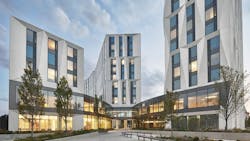University of Chicago unveils 400,000-square-foot residential complex
The University of Chicago is opening a 400,000-square-foot residence hall and dining commons this week that will house 800 undergraduate students.
The Campus North Residential Commons and Frank and Laura Baker Dining Commons, scheduled to open on Sept. 17, also will have university classrooms, offices for campus and student life, outdoor green spaces and 10,000 square feet of street-level retail space.
“This facility creates an elegant and welcoming new home for students and an important resource for our community,” says John W. Boyer, the university’s dean of the college. “The College is stronger when students can live and learn in communities that foster curiosity and intellectual conversations and serve as foundations for lifelong friendships.”
The building was designed by Studio Gang Architects, a firm led by architect Jeanne Gang.
“This is a beautiful and inspiring building,” says University President Robert J. Zimmer. “Jeanne Gang and her colleagues have made an outstanding contribution to our campus, to architecture designed to connect individuals and build communities, and to the relationship of our campus to its surroundings.”
Video: Architect Jeanne Gang discusses the project:
Another Studio Gang project, the 98-story Vista Tower in downtown Chicago, will be the tallest building in the world designed by a woman-owned firm. Workers broke ground on the building last week.
The new student housing at the University of Chicago has a contemporary facade of custom white, pre-cast concrete panels, with subtle arcs that recall the campus’s history of Gothic and neo-Gothic architecture.
On Monday, DNAInfo Chicago reports, Gang led visitors through the $148 million residence hall. She says the idea for the complex was to better connect the neighborhood and campus.
Rows of student rooms extend down curving hallways, and as one walks away from the common areas, the hallways get bigger and rooms go from doubles to single apartments with kitchenettes.
The Residential Commons’ three towers have varying heights. A five-story tower is scaled to the residential neighborhood to the east, and the tallest structure, reaching to 15 stories, complements the commercial context of 55th Street to the north.
The project was designed with a goal of achieving LEED Gold certification. The buildings embrace environmental sustainability by bringing maximum natural light and fresh air to interior spaces. The tallest tower is positioned to capture north-south light, naturally improving the overall energy efficiency of the entire complex.
Each student's residence is provided with automated controls to account for variable sun exposure. Glass surfaces are patterned with a ceramic frit that helps birds navigate around the structure and minimizes bird strikes.
Custom grilles on the residential windows enable students to open them for fresh air and ventilation. Expansive green roof systems help retain 100 percent of rainwater on site, and used cooking oil from the dining commons is pumped into a central tank and recycled into biofuel.
About the Author
Mike Kennedy
Senior Editor
Mike Kennedy, senior editor, has written for AS&U on a wide range of educational issues since 1999.
